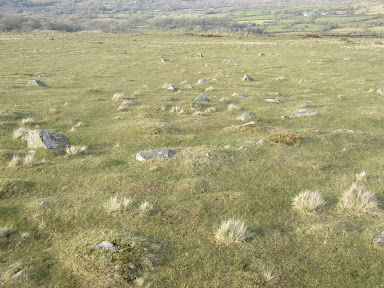I'm increasingly intrigued by these little buildings and enclosures on the edge of the common land in the Newport area. The top one is called Ty-Col, and is near the Bedd Morris standing stone to the west of Newport Pembs. The other is called Pen-lan-Oleu, and is to the north of Cnwc yr Hydd, near Tafarn y Bwlch. I assumed they were both "ty unnos" or "caban unnos" buildings originally, given their locations, and I guessed their date of construction to be around 1810. The latter one was still inhabited in the Second World War -- as was the building called Carningli Lodge, on the edge of the common near Carningli.
So I guessed that these ruins had survived as viable places of residence for 5 generations -- which is much longer than many of the "illegal" houses build on the edges of the commons in other parts of the UK. They are classic longhouse designs, with stable, cowshed and pigsty at one end of the row, and the human habitation at the other end.
Anyway, I put out a request for information on the Heritage and History of Wales Facebook page, and in no time at all I had many replies. This is what I got from Ceridwen Cilshafe on the subject of Ty-Col: This 15 acre holding is mentioned in the 1584 Bronwydd papers, and was probably linked to the Cole family of Llwyngwair. The ruins indicate a longhouse, 108’ x 18’ in plan, and a small out- building. Reg Davies concluded that the longhouse contained a pig-cote, cow-house, a 30’ cottage and a barn. It may originally have been a Hafod, and there is a Hendre one mile NNE. The old Drovers’ Road passes 500 yards to the east. However, census records show that from 1841 to 1911 it was a dwelling for the Evans, Williams, Owens, James and Howells families. By 1933 Ty Col was in ruins. (info from Len Urwin)
I suppose its possible that Ty-Col was in more or less continuous occupation from around 1584 to around 1930. So it's been in ruins for around a century. The stonework is very rough indeed, and the walls are in a dangerous state; almost all of the mortar that was used has been washed away.
We must clearly be careful about labelling things on the basis of their location on the edge of the common! That having been said, I still think Pen-lan-Oleu is probably a "ty unnos" dwelling........
We like to think that "one night" cottages are unique to Wales -- but that's not true. Almost every country in the world seems to have a tradition that landless people (or young couples with no money) can secretly build a cottage overnight on waste land or common land, and get away withy it, on the grounds that some ancient law allows it. When you look for these ancient laws, they don't actually exist -- so the tradition probably arises from a resentment against landowners with wealth and power who presume to own land which others think should be part of the "commons"...........
In his book "Cotters and Squatters" Colin Ward says that the great majority of "overnight cottages" built in the British Isles were destroyed shortly after they were built, either by vengeful landowners who felt that their authority was being threatened, or by landowners intent on enclosing parts of the common (with or without Parliamentary approval), or by commoners who felt that with every reduction in the size of the common their own use of it for grazing, peat cutting, and rush gathering was compromised. So although many of the cottagers were supported by a wide circle of family and friends, it was not guaranteed that ALL of the poor people and tenant farmers of a district were in favour of the incremental shrinking of the common land that was essential for their own survival.
So if some older building like Ty-Col and some newer ones like Pen-lan-Oleu managed to survive on the edges of the common, while others across the UK were demolished almost as quickly as they were erected, what was different here in Pembrokeshire? I suspect that there might have been several factors at play:
1. The fact that the Barony of Cemaes -- a medieval institution -- still owned the commons of Carningli, Dinas and Preseli.
2. The ruinous nature of Newport Castle and the absence (for most of the time) of the Lord Marcher, leaving things in the hands of rather inefficient stewards who had some sympathies with the aspirations of tenants and landless families.
3. There were no other large and powerful families in the area who owned estates on the edges of the common and who sought to enlarge them via common-land enclosures.
4. The enclosures were generally for the benefit of "small" families rather than large estates, which meant there there was not the same level of animosity from the commoners that might have been expected if there had been "land grabs" by unpopular members of the gentry.
5. The "pressure"on the commons was reducing rather than building up, in the period after 1830, as people left the area to search for a better life in the growing industrial centres on the South Wales Coalfield. (In the period immediately after the Napoleonic Wars there was a local population increase, with the margin of cultivation moving uphill on the mountain slopes into areas that were very marginal in terms of climate and soil quality. But when people started to emigrate eastwards that trend was reversed, and many "new fields" were abandoned and allowed to revert back to wilderness. We can still see them in the landscape today.)
Paul Sambrook kindly reminded me that the Barony seems to have had a policy of allowing cottagers to build on the edges of the common, and that they collected rents on the buildings once they were habitable. So the environment for settlers was not nearly as hostile here as it was in other parts of the UK -- and even around the lowland commons of Pembrokeshire. I'll speculate that more cottages (maybe called "ty unnos" cottages and maybe not) were built around the Carningli and Preseli commons, and more of them survived, than might have been expected -- because of this rather unique set of local circumstances. On the other hand, of course many of them were build in very remote and difficult locations in which "smallholder life" was very tough indeed -- and eventually it was inevitable that they would be abandoned. But some of them --like Cot Llwyd -- survived and thrived!
PS Here is an interesting entry:
















































